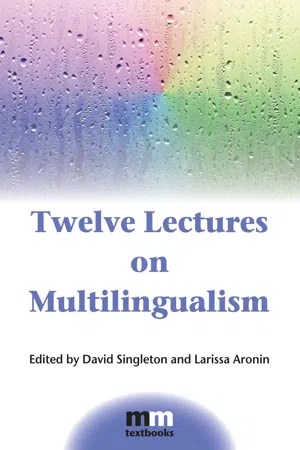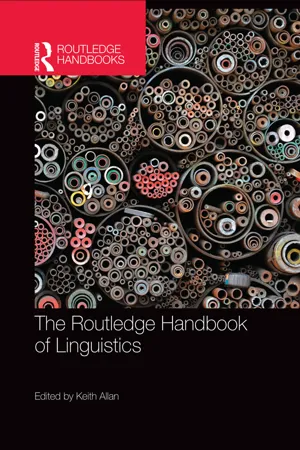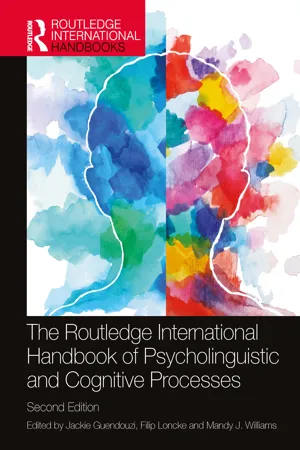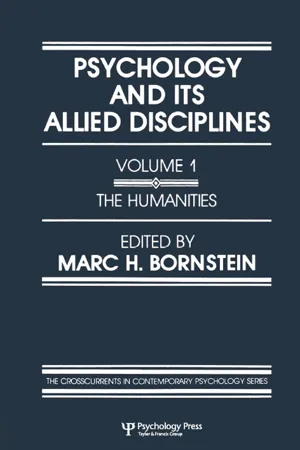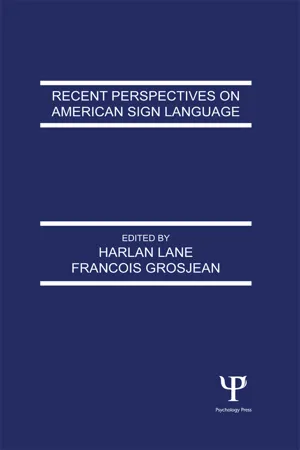Languages & Linguistics
Psycholinguistics
Psycholinguistics is the study of how language is processed and produced in the human mind. It explores the cognitive processes involved in language comprehension, production, and acquisition, as well as the neurological and psychological factors that influence language use. This interdisciplinary field draws on insights from psychology, linguistics, neuroscience, and cognitive science to understand the complex relationship between language and the human mind.
Written by Perlego with AI-assistance
Related key terms
Related key terms
1 of 4
Related key terms
1 of 3
10 Key excerpts on "Psycholinguistics"
- eBook - ePub
- Johannes Kabatek, Albert Wall, Johannes Kabatek, Albert Wall(Authors)
- 2022(Publication Date)
- De Gruyter(Publisher)
It is commonplace to define Psycholinguistics as the junction between linguistics and psychology, and beyond that, as a discipline that binds language acquisition and language processing studies. However, it is not simple to delineate a boundary between Psycholinguistics and linguistics, in the sense that almost every linguist in the world wants to understand the mechanisms that underlie our ability to communicate by sign, oral, and written language.“Psycholinguistics is the study of the mental processes and skills underlying the production and comprehension of the language, and of the acquisition of these skills” (Levelt 1992). Psycholinguistics aims to describe the underlying processes related to our capacity to communicate through a shared language in a certain community, rather than to generate knowledge about any particular language, such as Brazilian Portuguese (BP), for example.Psycholinguistics first emerged after two summer seminars at Cornell University in 1951 and at Indiana University in 1953 (Levelt 2013). The studies presented at those seminars were subsequently published in Psycholinguistics: a survey of theory and research problems by Osgood/Sebeok (1954), thus marking the beginning of the field. By the end of 1950s, the publication of Syntactic Structures (Chomsky 1957) added to the new discipline of Psycholinguistics, creating a fertile atmosphere for innovative research ideas and methodologies—a period that has become known in the history of linguistics as the “cognitive revolution”.It is important to note that at the beginning of 2021, more than ever, psycholinguists are seeking to resolve, through the use of computational methods and big data (Manning et al. 2020), the controversial debate on the role of the Faculty of Language in the narrow-sense (Hauser/Chomsky/Fitch 2002) and the role of linguistic input in language acquisition. In other words, psycholinguists are trying to identify what kinds of mechanisms allow humans to infer regularities from a large corpus of propositions received during the development of their languages, and are doing so through conducting experiments using behavioral, neurophysiological and computational methods. Psycholinguistics is considered to be one of the areas of cognitive science most closely related to cognitive psychology, the neuroscience of language, artificial intelligence, and computational linguistics. After many years of work, it is a dynamic field which is continuously creating new areas of study, such as biolinguistics, which studies language within the framework of evolution by describing how human biology constrains the lexicon and language structure, and socially-situated language processing studies, which investigate how social aspects influence the comprehension and production of speakers’ utterances. - eBook - ePub
- David Singleton, Larissa Aronin(Authors)
- 2018(Publication Date)
- Multilingual Matters(Publisher)
Part 3The Psycholinguistics and Neurolinguistics of MultilingualismPassage contains an image Lecture 9 The Psycholinguistics of Multilingualism Julia Festman What is Psycholinguistics?
Linguistics is the science of language , and psychology the science of behaviour . As a field of science, linguistics describes the structures that underlie language whereas psychology explains behaviour in terms of mental processes (De Groot, 2011). Psycholinguistics is in fact an interdisciplinary discipline to explore human language behaviour in depth. In my view, we can probably grasp only half of the story if we investigate language behaviour from the viewpoint only of psychology or of linguistics. In Psycholinguistics both disciplines conveniently converge to provide a comprehensive and detailed picture. Psycholinguistics is the science of linguistic behaviour; it is about how language is internally represented, how language is used and processed and how humans learn a language (Rickheit et al. , 2002).Crucial questionsPsycholinguistics as a discipline centres on three crucial questions about language and behaviour: (1) How is language knowledge organized? (2) How do we process language? and (3) How do we acquire language? We will consider these three questions in this lecture.1.How is language knowledge organized?One key goal of Psycholinguistics is to describe the content and organization of language knowledge in our mind, i.e. we assume that our language knowledge is stored in a ‘mental lexicon ’ and we have assumptions about how grammar is represented in the mind. Researchers in this discipline are interested in the organization of word knowledge (lexical knowledge) and how words can be combined (grammatical knowledge) in order for conveyed information to be comprehensible to the reader/listener.2.How do we process language? A second key goal of Psycholinguistics is to explore the mechanisms of language processing (Dietrich, 2007). Psycholinguists are searching for generally valid patterns of language production and language perception in order to find answers to the key questions of how we produce language output (i.e. language production ) and how we understand language input (i.e. language perception ). Four linguistic skills are hereby distinguished along the lines of modality: listening and speaking belong to the oral modality, whereas reading and writing are written forms of language. The four language skills - eBook - ePub
- Kristin Denham, Anne Lobeck(Authors)
- 2018(Publication Date)
- Routledge(Publisher)
9 Studying language in the brain PsycholinguisticsAs you read about in earlier chapters, a central question of linguistics is how we acquire knowledge of language as children. A great deal of evidence suggests that humans are born with the capacity to acquire language and are equipped with some inherent knowledge of language, making the complex task of acquiring language relatively easy, regardless of intellectual capacity, circumstances, or the language that one is exposed to. Psycholinguistics, or the psychology of language, encompasses a great many aspects of the study of language. Some claim, as Noam Chomsky himself has (1972), that linguistics itself can be considered a branch of psychology since psychology is the study of the mind and behavior, and the study of language is an important component of understanding the human mind and human behavior. Psycholinguistics is typically understood to include the study of the acquisition of language by children (sometimes known as L1 acquisition); the processing of language at all levels (phonological, morphological, syntactic, and at the discourse level); and the storage and access of words in the lexicon. Experimental methodologies common in psychology, such as eye-tracking, reaction time, and neural imaging, are often used to assess various aspects of language production, processing, and storage.First language acquisitionChild language acquisition provides us with a great deal of evidence for our innate capacity for language. Neuropsychologist Eric Lenneberg compares the acquisition of language to innate abilities in other species, including eyesight in cats and flight in birds. All such behaviors, he argues, share the following characteristics of biological behavior (Lenneberg, 1967): - eBook - ePub
- Keith Allan, Keith Allan(Authors)
- 2015(Publication Date)
- Routledge(Publisher)
Psycholinguistics Language and cognition Matthew J. Traxler18.1 Introduction: Why is Psycholinguistics significant?
We are what we do. What psycholinguists do is apply research methods derived mainly from the discipline of psychology to understand human behavior, thought, and neural processes as they relate to language function. Mainly because psycholinguists are a diverse bunch, they bring a diverse set of methods to the task of understanding how humans produce and understand language. Researchers in the field of Psycholinguistics include psychologists and linguists (of course, so long as said linguists are interested in mind, brain and behavior), but also computer scientists, anthropologists, sociologists, philosophers, statisticians, historians, literary scholars and a variety of other disciplines. Psycholinguistics, therefore, provides a prototypical example of a multidisciplinary approach to science.Psycholinguistics is a science, because psycholinguists apply the scientific method (observe, hypothesize, test, repeat), and it is as data-driven as any other scientific enterprise. The study of language in psychology at its inception was characterized by armchair philosophy, but those days are long gone. Beginning students of Psycholinguistics are often surprised that it is a science, and that they therefore need to learn how to apply the scientific method to language. This involves understanding how experiments are designed, how data are collected and analyzed, and how the human nervous system works.Psycholinguists have made numerous contributions to our theoretical understanding of how people represent knowledge about language, how people access and use this knowledge in real time to produce and understand language, how the human species acquired its current range of language abilities, and how neural systems support language function. These contributions are important not only because understanding how language works is a necessary part of understanding how human beings work, but also because there is a close relationship between language disorder and other kinds of mental disorder. This close connection between language function and overall mental function most likely reflects bi-directional causal relationships from language to non-linguistic cognition, and vice versa. When non-linguistic aspects of cognition (such as attention, executive control or working memory) go wrong, aspects of language function can go wrong. When aspects of language function go wrong (as in Specific Language Disorder, dyslexia and aphasia), this has consequences for the social and emotional functioning of the individual, as well as effects on educational and economic outcomes. Here is an example of each type of causal relation: - Jackie Guendouzi, Filip Loncke, Mandy J. Williams, Jackie Guendouzi, Filip Loncke, Mandy J. Williams(Authors)
- 2023(Publication Date)
- Routledge(Publisher)
Some basic considerations Jackie Guendouzi and Filip LonckeDOI: 10.4324/9781003204213-1Introduction
As noted in the first edition we did not intend this collection to be an extensive survey of the field of Psycholinguistics. Rather, the aim of the book was to provide a tutorial resource that combines research from Psycholinguistics and cognitive sciences with the field of communication disorders. The information presented here does not require prior knowledge but it does assume some basic knowledge in the area of linguistics or cognitive sciences. The second edition includes 18 updated or revised chapters that include new authors. However, several of the original chapters remain because they reflect seminal areas of knowledge in the fields of Psycholinguistics and communication disorders. Sadly, since the first edition, Heather van der Lely and Ursula Bellugi both passed away. Van der Lely’s research (see Chapter 20 ) was influential in generating debate in the area of Specific Language Impairment (SLI) while Bellugi’s phenomenal career pioneered work that aligned cognitive science with the study of sign language (see Chapter 32 ). In both cases, their contributions to this book reflect their influence within their respective areas of research and make for compelling reading.The field of Psycholinguistics has yielded many diverse and competing theories over the years; some more than others have dominated language research. As seen in this text, there are multiple approaches to the question of how we process language. Readers should draw their own conclusions as to the robustness of specific models or theories; exploring theoretical questions is an ongoing process that rarely arrives at a definitive answer, there is always more to discover. As with the first edition, we feel it is helpful to start the introduction by providing some historical context to the field of Psycholinguistics and its relationship with communication disorders.- eBook - ePub
- Alison Wray, Aileen Bloomer(Authors)
- 2013(Publication Date)
- Routledge(Publisher)
Part I Areas of Study and Project Ideas DOI: 10.4324/9780203768990-2Passage contains an image
Psycholinguists ask questions such as the following:2 Psycholinguistics
DOI: 10.4324/9780203768990-3- How does our brain organize the words that it stores?
- How does it access them so quickly and efficiently?
- What causes the tip-of-the-tongue phenomenon, when a word just won't come to mind?
- Why are we more likely to mishear something that is out of context?
- How do we know how to finish off a sentence that someone else starts?
- How similar are the processes of listening and reading?
- When the brain encounters a sentence it has never seen or heard before, does it have to look everything up in some vast dictionary and grammar store, or are there shortcuts that it can take to work out what it means?
- Does the brain process the words in the order in which it hears or sees them, or does it store up strings of words and then process them all at once?
- Why don't we take idioms like He's one sandwich short of a picnic literally?
- How do we know when someone has made a mistake in what they have said?
- What mechanisms operate during speech production to ensure that all the words come out in the right order and with the right intonation?
- What can the language of brain-damaged people tell us about how language-processing occurs?
Textbooks and major journals
Psycholinguistics is a sub-discipline of both psychology and linguistics, and the slant within textbooks varies accordingly, so you are likely to encounter some rather different viewpoints and approaches. Aim for recent publications when you are trying to get an overview of what the current issues are. Useful introductory texts include Aitchison (2011 , 2012 ), Field (2003) , Steinberg and Sciarini (2006) , Carroll (2008) , Harley (2010) and the more detailed Steinberg, Nagata, and Aline (2001) . Also check handbooks (e.g. Gaskell 2009 and Traxler and Gernsbacher 2006 , plus Kroll and De Groot 2005 on psycholinguistic approaches to bilingualism, and Guendouzi, Loncke and Williams 2011 for a focus on communication disorders) and various entries in linguistics encyclopaedias (especially Brown 2006 ). Harley's (2011) six-volume set of state-of-the-art overviews of issues in Psycholinguistics is a treasure trove, if your library has a copy. Psychology textbooks that focus on language include Harley (2007) and there are chapters on language in Eysenck and Keane (2010) and Pinel (2011) . For project ideas, Field (2005) and Prideaux (1990) are good sources, and Clark and Clark (1977) - eBook - ePub
A History of Applied Linguistics
From 1980 to the present
- Kees de Bot(Author)
- 2015(Publication Date)
- Routledge(Publisher)
7 Trends II Psycholinguistic, sociolinguistic and educational aspectsFor the topical organization of the trends mentioned in the previous chapter that do not deal with theories and research methodology, the traditional distinction between psycholinguistic, sociolinguistic and educational aspects has been used, even though over time the boundaries between these first two have become less clear.7.1 Psycholinguistic aspects: language and cognitionThe definition of Psycholinguistics in AL is not clear. It seems to refer to all approaches that see language primarily as an individual’s commodity residing in the brain. SLA research looks at how humans develop and use languages. In some theories the human learner is endowed with a special language acquisition device that is innate. Input triggers the language acquisition device and limits the set of possible patterns and rules. A core issue in this tradition is to what extent the innate capacities that play a role only in first language acquisition, also play a role in the acquisition of later learned languages. While this issue was hot in the 1990s, the issue seems to have petered out after that, with no empirical evidence to decide between the two options. In other theories no innateness is assumed, and language development results from the interaction of basic, non-linguistic cognitive skills with a rich linguistic environment.7.1.1 The role of input, output and interactionThe role of input has become one of the main issues in AL. It was a prominent feature of the Krashen model, in particular in the form of comprehensible input. Because it turned out to be difficult to define comprehensible input, it lost importance, even more so when Swain started stressing the need for output on the basis of findings in Canadian immersion education. But input continues to be crucial for development. Stephen Krashen says: “Most important for me is that we no longer assume that we acquire languages by conscious learning and output practice. This was an axiom, but it has been demoted to the status of hypothesis.” According to Robert DeKeyser, input is seen as more important now than in the past. Elizabeth Lanza concurs: - eBook - ePub
Psychology and Its Allied Disciplines
Volume 1: Psychology and the Humanities
- M. H. Bornstein(Author)
- 2019(Publication Date)
- Psychology Press(Publisher)
The remoteness of these theories of language acquisition from what can be observed empirically is as obvious as it is regrettable. Developmental psycholinguists have established beyond doubt that children do not learn their language by being reinforced for speaking grammatically (Brown, 1973). They have also collected many observations about the nature of both the language that children speak and the language that is spoken to them. Yet, more than one warning has been recently sounded to the effect that the field may collapse under the weight of inconsistent and inexplicable data. The best hope for avoiding this fate is a renewed attempt to devise theories of acquisition that have obvious observational consequences.CONCLUSIONSThere is a fine irony in the way in which, in the past, generative grammarians have ignored psychological phenomena, since its proponents generally argue that linguistics is a branch of psychology. What are the main psychological phenomena? The most important ones are so obvious that they are seldom noticed:Speaking and understanding language depend on processes almost entirely outside conscious awareness. It is impossible to discover anything of importance about grammatical rules or semantic representations by introspection. The most frequently used words are precisely those that are the most ambiguous, and thus their interpretation depends on an ability to make inferences from linguistic context. Utterances invariably depend on the circumstances in which they are uttered for their correct interpretation, and thus in turn on an ability to make inferences from those circumstances.It is these phenomena that maintain the existence of both theoretical linguistics and experimental Psycholinguistics. Neither subject would exist if you could recover the rules of your language, and the mental processes that underlie your use of them, without ever stirring from an introspective posture.Modern Psycholinguistics arose from a combination of linguistic theories and psychological experiments. After a promising beginning, a hiatus occurred because the mathematical conception of grammar pulled in one direction and the experimental facts pulled in another. It now seems that perhaps the mathematical pull was not entirely along the right lines. If this conjecture proves to be correct, then the way is clear once more for a mutual attack upon the problems of language. Certainly, this approach is needed. What the phenomena above undoubtedly imply is that the most powerful mental machinery for coping with language is profoundly hidden and highly inferential. - eBook - ePub
- Annette M. B. de Groot, Peter Hagoort, Annette M. B. de Groot, Peter Hagoort(Authors)
- 2017(Publication Date)
- Wiley-Blackwell(Publisher)
The picture for Psycholinguistics is largely similar. With the notable exception of language acquisition research (e.g, Bowerman & Brown, 2008; Slobin, 1985), most psycholinguistic research has been done with speakers of English, or other European languages. Jaeger and Norcliffe (2009), for instance, found sentence production research relies on data from only 0.6% of the world’s languages (cf. Norcliffe, Harris, & Jaeger, 2015). This is problematic because English, and other “Standard Average European” languages, do not adequately portray the world’s linguistic diversity (Dahl, 2015), and this leads researchers to disproportionately focus on patterns imposed by Eurocentric linguistic traditions (Whorf, 1944; Gil, 2001). Similarly, the sociodemographic characteristics of speakers typically participating in psycholinguistic experiments—that is, “WEIRD”: Western, Educated, Industrialized, Rich and Democratic—make them unusual when compared to the rest of the world (Henrich, Heine, & Norenzayan, 2010; Majid & Levinson, 2010). For instance, there is a strong focus on monolinguals in psycholinguistic studies, which ignores the fact that worldwide multilingualism is rampant. In sum, an approach restricted to a largely homogenous sample fails to recognize the world’s vast cultural and linguistic diversity (Evans & Levinson, 2009; Malt & Majid, 2013), tacitly assuming psycholinguistic universalism.In reality differences in grammatical and semantic structure have differential consequences for the encoding and decoding of utterances (e.g., Norcliffe, Harris, & Jaeger, 2015; Levinson, 2012), and can affect general cognitive processes (e.g., Majid et al., 2004; Wolff & Holmes, 2011). We focus here on the lesser‐known languages spoken outside urban areas, but since cross‐linguistic Psycholinguistics is in its infancy, even relatively well‐described languages (e.g., Tagalog), can offer novel insights (e.g., Sauppe et al., 2013).What Does It Entail? Best Practice
Each language presents a unique set of challenges to a researcher. The requirements and procedure followed in a field study will thus vary considerably from place to place depending on a number of practical and theoretical issues related to the field site logistics, sociocultural and linguistic background of the study population, state of language documentation, research questions, and so on. There are a number of excellent guides (e.g., Bowern, 2008; Crowley, 2007; Sakel & Everett, 2012), and handbooks (e.g., Gippert, Himmelmann, & Mosel, 2006; Newman & Ratliff, 2001; Thieberger, 2011) on linguistic fieldwork, so we will only flag some key general issues, focusing specifically on psycholinguistic methods in the field.The first prerequisite for successful psycholinguistic research in the field is familiarity with the language and culture under study. What this means in practice is long‐term involvement with the community. If a language has not been previously studied, fieldwork will also require doing basic description to provide the groundwork for pursuing more advanced questions. If, on the other hand, a sufficiently good grammatical description already exists, getting to know the language will be easier. Knowing the language and culture is crucial not only because it enables you to interact with speakers and carry out experiments, but also to ensure you do not overlook important links. Since it is impossible to determine a priori how an under‐described language works, fieldworkers cannot allow themselves the luxury of being interested only in syntax or only in morphology, but need a general mastery of the “whole language” (Hyman, 2001), and an understanding of its fit within the culture. For instance, sentence formulation is affected by word order, but at the same time it might also be driven by verb morphology (Norcliffe et al - eBook - ePub
- Harlan L. Lane, Francois Grosjean(Authors)
- 2017(Publication Date)
- Psychology Press(Publisher)
3Psycholinguistics of Sign Language 1François GrosjeanNortheastern UniversityIn this chapter we review a number of studies pertaining to the Psycholinguistics of sign language. We begin by summarizing those studies whose goal was to determine if sign language is as effective as spoken language for communication. Having responded in the affirmative to this question, we present an account of the studies that have demonstrated the psychological reality of certain aspects of the structural organization of sign language as it is described by linguistics. Next we study the production of sign language—what it has in common with spoken language and in what ways it is different—as well as the perception of sign: psychophysics of rate, iconic memory, and on-line processing of signs presented individually and in sentential context. We end the chapter with a résumé of studies bearing on the role of memory in sign language communication.Because our space is limited and because of a lack of systematic research, this chapter will not treat the following aspects of Psycholinguistics of sign language: communication between signers of different sign languages, the role of the figurative aspect of sign language and its perception and memorization, perception and production of contrived signing systems (such as Sign English), spoken—sign language bilingualism, and the acquisition of sign language as a native language. The latter topic is reviewed by Hoffmeister and Wilbur elsewhere in this book. Two further preliminaries: Although most of the studies that we cite are concerned with American Sign Language (ASL), we believe that the processes of production, perception, and memorization that will be examined are for the most part descriptive of other sign languages as well. Moreover, these processes should be compared to those for oral language and consequently we will attempt to clarify as far as possible the relations between the activities of the signer/observer and those of the speaker/listener. Psycholinguistics is addressed, after all, to the perception, understanding, and production of all languages, whether spoken or sign. No model of linguistic performance can be complete unless it describes those aspects of encoding and decoding that are specific to the modality of communication, oral or visual, and those that are common to all languages whatever their modality of perception and production.
Index pages curate the most relevant extracts from our library of academic textbooks. They’ve been created using an in-house natural language model (NLM), each adding context and meaning to key research topics.
Explore more topic indexes
Explore more topic indexes
1 of 6
Explore more topic indexes
1 of 4

